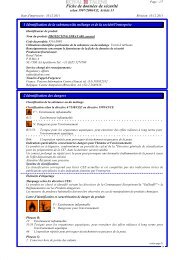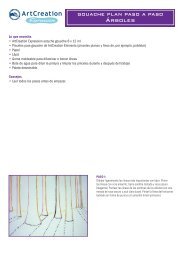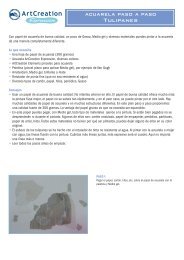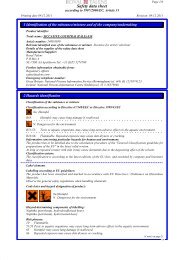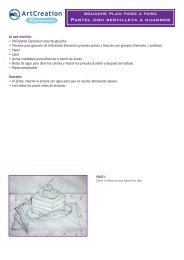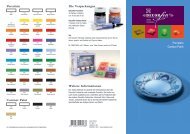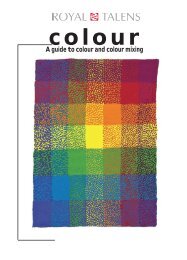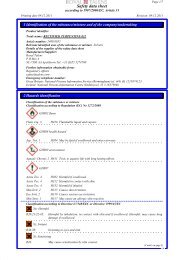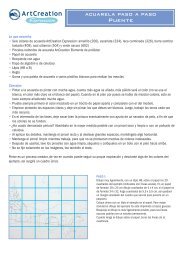Painting Medium 083 - Royal Talens
Painting Medium 083 - Royal Talens
Painting Medium 083 - Royal Talens
Create successful ePaper yourself
Turn your PDF publications into a flip-book with our unique Google optimized e-Paper software.
DR<br />
Safety data sheet<br />
according to 1907/2006/EC, Article 31<br />
Page 1/6<br />
Printing date 09.12.2011 Revision: 09.12.2011<br />
1 Identification of the substance/mixture and of the company/undertaking<br />
· Product identifier<br />
· Trade name: PAINTING MEDIUM <strong>083</strong><br />
· Article number: 2400.0<strong>083</strong><br />
· Relevant identified uses of the substance or mixture medium for oilpaint<br />
· Details of the supplier of the safety data sheet<br />
· Manufacturer/Supplier:<br />
<strong>Royal</strong> <strong>Talens</strong><br />
P.O.Box 4<br />
NL-7300 AA Apeldoorn Tel. +31 (0)55 5274700<br />
· Further information obtainable from:<br />
Regulatory Affairs<br />
safety@talens.com<br />
· Emergency telephone number:<br />
Great Britain: National Poisons Information Service (Bermingham) tel. (44) (0) 1215074123<br />
Ireland: National Poisons Information Centre (Dublin) tel. 35 3 18379966<br />
2 Hazards identification<br />
· Classification of the substance or mixture<br />
· Classification according to Directive 67/548/EEC or Directive 1999/45/EC<br />
N; Dangerous for the environment<br />
R51/53: Toxic to aquatic organisms, may cause long-term adverse effects in the aquatic environment.<br />
R10-66: Flammable. Repeated exposure may cause skin dryness or cracking.<br />
· Information concerning particular hazards for human and environment:<br />
The product has to be labelled due to the calculation procedure of the "General Classification guideline for<br />
preparations of the EU" in the latest valid version.<br />
At long or repeated contact with skin it may cause dermatitis due to the degreasing effect of the solvent.<br />
· Classification system:<br />
The classification is according to the latest editions of the EU-lists, and extended by company and literature<br />
data.<br />
· Label elements<br />
· Labelling according to EU guidelines:<br />
The product has been classified and marked in accordance with EU Directives / Ordinance on Hazardous<br />
Materials.<br />
Observe the general safety regulations when handling chemicals.<br />
· Code letter and hazard designation of product:<br />
N Dangerous for the environment<br />
· Hazard-determining components of labelling:<br />
Naphtha (petroleum), hydrodesulfurized heavy<br />
Distillates (petroleum), hydrotreated light<br />
· Risk phrases:<br />
10 Flammable.<br />
51/53 Toxic to aquatic organisms, may cause long-term adverse effects in the aquatic environment.<br />
66 Repeated exposure may cause skin dryness or cracking.<br />
· Safety phrases:<br />
2 Keep out of the reach of children.<br />
24 Avoid contact with skin.<br />
29 Do not empty into drains.<br />
46 If swallowed, seek medical advice immediately and show this container or label.<br />
(Contd. on page 2)<br />
GB
DR<br />
Safety data sheet<br />
according to 1907/2006/EC, Article 31<br />
Page 2/6<br />
Printing date 09.12.2011 Revision: 09.12.2011<br />
· Other hazards<br />
· Results of PBT and vPvB assessment<br />
· PBT: Not applicable.<br />
· vPvB: Not applicable.<br />
(Contd. of page 1)<br />
3 Composition/information on ingredients<br />
· Chemical characterization: Mixtures<br />
· Description: Mixture of substances listed below with nonhazardous additions.<br />
· Dangerous components:<br />
CAS: 64742-82-1<br />
EINECS: 265-185-4<br />
Naphtha (petroleum), hydrodesulfurized heavy<br />
Xn R65; N R51/53<br />
R10-66-67<br />
CAS: 64742-47-8 Distillates (petroleum), hydrotreated light<br />
EINECS: 265-149-8 Xn R65<br />
R66<br />
· Additional information: For the wording of the listed risk phrases refer to section 16.<br />
25-50%<br />
10-25%<br />
4 First aid measures<br />
· Description of first aid measures<br />
· After skin contact: Immediately wash with water and soap and rinse thoroughly.<br />
· After eye contact: Rinse opened eye for several minutes under running water.<br />
· After swallowing: Do not induce vomiting; call for medical help immediately.<br />
5 Firefighting measures<br />
· Extinguishing media<br />
· Suitable extinguishing agents: CO2, sand, extinguishing powder. Do not use water.<br />
· Special hazards arising from the substance or mixture No further relevant information available.<br />
· Advice for firefighters<br />
· Protective equipment: No special measures required.<br />
6 Accidental release measures<br />
· Personal precautions, protective equipment and emergency procedures<br />
Ensure adequate ventilation<br />
Keep away from ignition sources.<br />
· Environmental precautions: Do not allow to enter sewers/ surface or ground water.<br />
· Methods and material for containment and cleaning up:<br />
Absorb with liquid-binding material (sand, diatomite, acid binders, universal binders, sawdust).<br />
· Reference to other sections<br />
See Section 7 for information on safe handling.<br />
See Section 8 for information on personal protection equipment.<br />
See Section 13 for disposal information.<br />
7 Handling and storage<br />
· Handling:<br />
· Precautions for safe handling No special precautions are necessary if used correctly.<br />
· Information about fire - and explosion protection:<br />
Keep ignition sources away - Do not smoke.<br />
Protect against electrostatic charges.<br />
(Contd. on page 3)<br />
GB
DR<br />
Safety data sheet<br />
according to 1907/2006/EC, Article 31<br />
Page 3/6<br />
Printing date 09.12.2011 Revision: 09.12.2011<br />
· Conditions for safe storage, including any incompatibilities<br />
· Storage:<br />
· Requirements to be met by storerooms and receptacles: No special requirements.<br />
· Information about storage in one common storage facility: Not required.<br />
(Contd. of page 2)<br />
8 Exposure controls/personal protection<br />
· Exposure controls<br />
· Personal protective equipment:<br />
· General protective and hygienic measures: Wash hands before breaks and at the end of work.<br />
· Respiratory protection: Not necessary if room is well-ventilated.<br />
· Protection of hands:<br />
If prolonged or repeated contact is likely, chemicalresistant gloves are recommended.<br />
· Material of gloves Nitrile rubber, NBR<br />
· Penetration time of glove material<br />
The exact break trough time has to be found out by the manufacturer of the protective gloves and has to be<br />
observed.<br />
· Eye protection:<br />
Safety glasses if risk of splashes.<br />
9 Physical and chemical properties<br />
· Information on basic physical and chemical properties<br />
· General Information<br />
· Appearance:<br />
Form:<br />
Fluid<br />
Colour:<br />
According to product specification<br />
· Odour: Characteristic<br />
· Change in condition<br />
Melting point/Melting range: Undetermined.<br />
Boiling point/Boiling range: 175°C<br />
· Flash point: 43°C<br />
· Ignition temperature: 200°C<br />
· Danger of explosion: Product is not explosive. However, formation of explosive air/vapour<br />
mixtures are possible.<br />
· Explosion limits:<br />
Lower: 0.5 Vol %<br />
Upper: 7.0 Vol %<br />
· Vapour pressure at 20°C: 27 hPa<br />
· Density at 20°C: 0.85 g/cm³<br />
· Solubility in / Miscibility with<br />
water:<br />
· Viscosity:<br />
Dynamic at 20°C:<br />
Not miscible or difficult to mix.<br />
9 mPas<br />
(Contd. on page 4)<br />
GB
DR<br />
Safety data sheet<br />
according to 1907/2006/EC, Article 31<br />
Page 4/6<br />
Printing date 09.12.2011 Revision: 09.12.2011<br />
· Other information No further relevant information available.<br />
(Contd. of page 3)<br />
10 Stability and reactivity<br />
· Reactivity<br />
· Chemical stability<br />
· Thermal decomposition / conditions to be avoided: No decomposition if used according to specifications.<br />
· Possibility of hazardous reactions No dangerous reactions known.<br />
· Conditions to avoid No further relevant information available.<br />
· Incompatible materials: No further relevant information available.<br />
11 Toxicological information<br />
· Information on toxicological effects<br />
· Acute toxicity:<br />
· LD/LC50 values relevant for classification:<br />
64742-82-1 Naphtha (petroleum), hydrodesulfurized heavy<br />
Oral LD50 > 5000 mg/kg (rat)<br />
Dermal LD50 > 2000 mg/kg (rabbit)<br />
· Primary irritant effect:<br />
· on the skin: Irritant to skin and mucous membranes.<br />
· Sensitization: No sensitizing effects known.<br />
12 Ecological information<br />
· Behaviour in environmental systems:<br />
· Bioaccumulative potential No further relevant information available.<br />
· Mobility in soil No further relevant information available.<br />
· Ecotoxical effects:<br />
· Remark: Toxic for fish<br />
· Additional ecological information:<br />
· General notes:<br />
Water hazard class 2 (German Regulation) (Self-assessment): hazardous for water<br />
Do not allow product to reach ground water, water course or sewage system.<br />
Danger to drinking water if even small quantities leak into the ground.<br />
Also poisonous for fish and plankton in water bodies.<br />
Toxic for aquatic organisms<br />
· Results of PBT and vPvB assessment<br />
· PBT: Not applicable.<br />
· vPvB: Not applicable.<br />
· Other adverse effects No further relevant information available.<br />
13 Disposal considerations<br />
· Waste treatment methods<br />
· Recommendation<br />
Must not be disposed together with household garbage. Do not allow product to reach sewage system.<br />
· Uncleaned packaging:<br />
· Recommendation: Disposal must be made according to official regulations.<br />
GB<br />
(Contd. on page 5)
DR<br />
Safety data sheet<br />
according to 1907/2006/EC, Article 31<br />
Page 5/6<br />
Printing date 09.12.2011 Revision: 09.12.2011<br />
(Contd. of page 4)<br />
14 Transport information<br />
· UN-Number<br />
· ADR, IMDG, IATA UN1263<br />
· UN proper shipping name<br />
· ADR 1263 PAINT RELATED MATERIAL, ENVIRONMENTALLY<br />
HAZARDOUS<br />
· IMDG PAINT RELATED MATERIAL (TURPENTINE SUBSTITUTE)<br />
· IATA PAINT RELATED MATERIAL<br />
· Transport hazard class(es)<br />
· ADR<br />
· Class 3 Flammable liquids.<br />
· Label 3<br />
· IMDG<br />
· Class 3 Flammable liquids.<br />
· Label 3<br />
· IATA<br />
· Class 3 Flammable liquids.<br />
· Label 3<br />
· Packing group<br />
· ADR, IMDG, IATA III<br />
· Environmental hazards: Product contains environmentally hazardous substances:<br />
Naphtha (petroleum), hydrodesulfurized heavy<br />
· Marine pollutant: Yes<br />
Symbol (fish and tree)<br />
· Special marking (ADR): Symbol (fish and tree)<br />
· Special precautions for user Warning: Flammable liquids.<br />
· Danger code (Kemler): 30<br />
· EMS Number: F-E,S-E<br />
· Transport in bulk according to Annex II of<br />
MARPOL73/78 and the IBC Code<br />
· Transport/Additional information:<br />
· ADR<br />
· Tunnel restriction code D/E<br />
Not applicable.<br />
GB<br />
(Contd. on page 6)
DR<br />
Safety data sheet<br />
according to 1907/2006/EC, Article 31<br />
Page 6/6<br />
Printing date 09.12.2011 Revision: 09.12.2011<br />
(Contd. of page 5)<br />
15 Regulatory information<br />
· Safety, health and environmental regulations/legislation specific for the substance or mixture<br />
· Labelling according to EU guidelines:<br />
The product has been classified and marked in accordance with EU Directives / Ordinance on Hazardous<br />
Materials.<br />
Observe the general safety regulations when handling chemicals.<br />
· Code letter and hazard designation of product:<br />
N Dangerous for the environment<br />
· Hazard-determining components of labelling:<br />
Naphtha (petroleum), hydrodesulfurized heavy<br />
Distillates (petroleum), hydrotreated light<br />
· Risk phrases:<br />
10 Flammable.<br />
51/53 Toxic to aquatic organisms, may cause long-term adverse effects in the aquatic environment.<br />
66 Repeated exposure may cause skin dryness or cracking.<br />
· Safety phrases:<br />
2 Keep out of the reach of children.<br />
24 Avoid contact with skin.<br />
29 Do not empty into drains.<br />
46 If swallowed, seek medical advice immediately and show this container or label.<br />
· Chemical safety assessment: A Chemical Safety Assessment has not been carried out.<br />
16 Other information<br />
This information is based on our present knowledge. However, this shall not constitute a guarantee for any<br />
specific product features and shall not establish a legally valid contractual relationship.<br />
· Relevant phrases<br />
R10 Flammable.<br />
R51/53 Toxic to aquatic organisms, may cause long-term adverse effects in the aquatic environment.<br />
R65 Harmful: may cause lung damage if swallowed.<br />
R66 Repeated exposure may cause skin dryness or cracking.<br />
R67 Vapours may cause drowsiness and dizziness.<br />
GB



